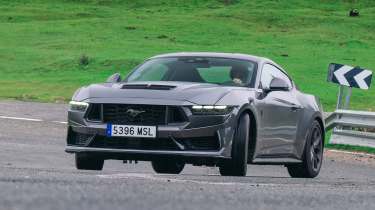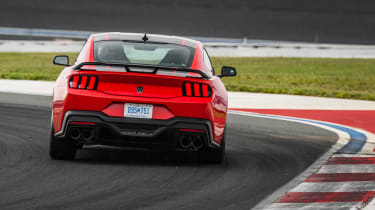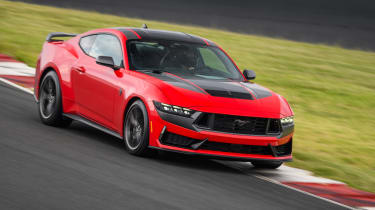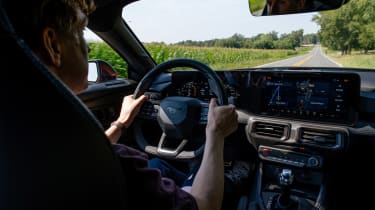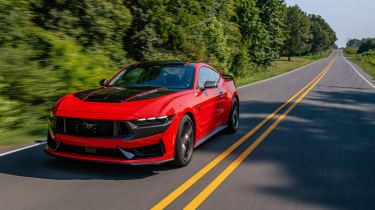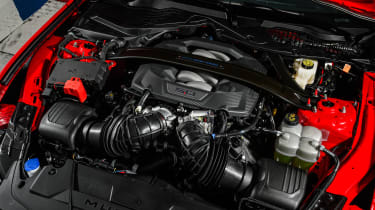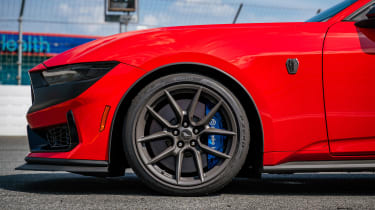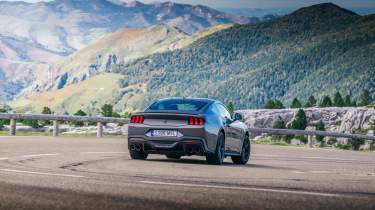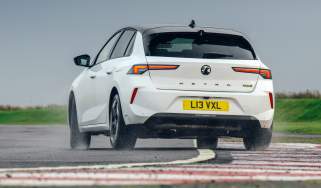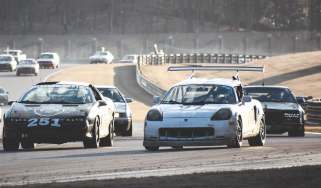Ford Mustang Dark Horse 2025 review – the last of a dying breed
The Mustang fights on with a naturally aspirated V8, manual gearbox and a track-focused Dark Horse variant. We put it through its paces
The Ford Tourneo people-carrier cants over like a listing ship. Passengers’ heads tilt in unison, shifting like the bubble in a spirit level. Grab handles are grabbed, torsos are braced against seats – or, for those sitting on the left-hand side, the windows. We’ve just entered the first banked turn of the Charlotte Motor Speedway, and is it ever steep.
We’re on a sighting lap before driving the circuit in the new Ford Mustang Dark Horse, with the Ford racing school’s chief instructor at the Tourneo’s wheel to show us the best way around the really rather technical Charlotte ‘Roval’ course, which packs hairpins, sweepers and a surprising amount of elevation and camber inside the outer oval.
And it says a lot for the Mustang that a few minutes later, tackling the banking for the first time for real, it feels the most natural thing in the world to keep the throttle pinned wide open, trusting the car implicitly. That follows, because the Dark Horse is designed to be the most track-capable core model in the seventh-gen Mustang line-up. It sits above a 2.3-litre EcoBoost four-cylinder entry-level car (which we don’t get in the UK) and the mid-range 5-litre V8 Mustang GT. There’ll be more extreme Mustang variants: a new 5.2-litre Shelby is highly likely and the wild Mustang GTD limited edition is on its way, but in terms of ‘normal’ 5-litre Mustangs, this is the top of the tree.
More reviews
In-depth reviews
Reviews
- Ford Mustang GT 2024 review – old school in all the right ways
- Ford Mustang Mach-E GT 2023 review – it’s fast, but is it fun?
- Used Ford Mustang (Mk6, 2015 to date) review and buyer’s guide
- Ford Mustang Shelby GT500 UK review – how does Ford’s maddest muscle car handle Blighty?
- Ford Mustang Mach 1 2021 review – America’s BMW M4 gets track fit
- Ford Mustang Steve McQueen Bullitt Edition 2021 review – a 720bhp tribute act
Compared with its GT stablemate, the Dark Horse gets upgrades including extra power, bigger brakes, and cooling and aerodynamic improvements. It's based on the Mk7 Mustang, which is not an all-new, clean-sheet car: squint at its outline, blurring out the nips and tucks – and in the Dark Horse’s case, a darkened colour-break around the grille, lower side skirts and a different rear wing – and you can still make out the hard points of the sixth-gen model. It’s the same story inside, where there’s much that’s familiar. The A-pillar mouldings, door cards and lower centre console all look very much like carryovers, though the screen-dominated dash is all new – more on which in a bit.
First, back to that 24-degree banking. Admittedly, we’re not piling into it at the end of a fast straight: the road course layout puts a tight hairpin just before it. But the Dark Horse is a car you quickly feel at ease with, and one that enjoys being driven quickly. It’s still bulky, weighing 1762kg with dimensions all but identical to the previous generation car, but the balance is benign, and its limits feel a little less spiky than in the Mach 1, the model the Dark Horse indirectly replaces.
Ford has altered the strut tower bracing with the aim of better steering feedback, and given the Dark Horse larger rear anti-roll bars than other Mustangs, along with a unique calibration for its standard-fit MagneRide dampers (an option on other Mustangs). Six-piston Brembo calipers at the front grab 390mm discs, and the Dark Horse stops well for a car of this size, although our runs are limited to three-lap bursts, including a warm-up and cool-down tour.
Like the Mustang GT, the Dark Horse is powered by the latest evolution of Ford’s 5-litre Coyote V8, albeit with further upgrades including the lighter con-rods used in the 5.2-litre Shelby GT500, but not that car’s flat-plane crankshaft. Open nostrils in the Dark Horse’s front grille feed dual throttle bodies, and it has a lighter radiator than other variants, with more powerful cooling fans, along with a diff cooler for track work and a separate transmission oil cooler for manual cars (buyers can choose between six-speed manual or ten-speed auto), plus extra NACA intakes for the brake cooling ducts.
In the US it develops around 500bhp; in the UK, emissions and homologation requirements drop that to 447bhp. There’s more than an ECU tweak at play in the power gulf between UK and US cars, with additional particulate filters and an altered exhaust system. No doubt a few specialist tuners have already devised ways to round up some of the missing horses, plus a few more.
You can hold the throttle wide open on upshifts, the flat-shift map enabling you to keep the pedal buried in the carpet while dipping the clutch and hooking the next gear. It’s good fun, although gut feel says it’s not a huge deal faster than doing it yourself with a quick lift of the throttle.
That six-speed manual is almost identical to the lovely, tactile, short-throw Tremec unit fitted to the Mach 1, and it’s every bit as rewarding to use here. In place of the previous car’s white plastic cueball gearknob, the Dark Horse gets a blue anodised titanium one which, despite being hollow, gets scaldingly hot in the sun. I frantically direct the air-con vents towards it after grasping it for the first time.
As with the Mach 1, there’s nicely calibrated automatic throttle-blipping on downshifts, although you can disable that and do it yourself if you prefer. It’s mostly foolproof although, braking into the about-face hairpin following the banking, a couple of times I hear the rear tyres chirrup and feel a squirm from the rear axle. Those tyres are new Pirelli PZ4s, with a bespoke construction developed for the car. Their edge of grip is smooth at the limit and, with a similar Torsen limited-slip diff to the Mach 1, the Dark Horse hooks up well out of slow corners.
We sample the ten-speed auto on the track too. For the first lap I select Track mode, leave the paddles untouched and keep it in auto to see how it fares. Remarkably well, it turns out, somehow finding the right gear at the right time in both fast and slow corners. Ford’s engineers later explain that the long-suffering transmission software calibration team rode shotgun with the development drivers on track, and as a result the ’box can sense if you’re hard on the brakes for a hairpin and need to barrel down the gears, or if you’re delicately trailing the brakes into a long, fast corner, and need to hold a gear. That work feels like it’s paid off, even if the Tremec manual is more fun to arm-wrestle with. Later we’ll drive the ten-speed auto on the road, too; with so many ratios, its gearing is relatively short through the first few ratios, and shifts feel slurry at times; the manual is the more satisfying drive.
There are still various track-based modes as per the previous Mustang: Line Lock to keep pressure in the front brake lines and free the rears for smoky burnouts; Drag Strip to soften the rear dampers for optimum quarter-mile runs; and personal-best timers for acceleration and braking runs. One of the most intriguing, which sadly we don’t have time or space to try out during our short acquaintance, is the Electronic Drift Brake. In place of the previous car’s manual handbrake is an electronic lever in the same spot. In addition to its day job as a parking brake, it’s designed to be used for tipping the car into a slide. ‘Handbrake turns kind of went away with e‑brakes; we wanted to bring that back,’ says Mustang vehicle integration supervisor Tim Smith. A laudable aim. Once you’ve selected the appropriate mode via the touchscreen, the system loads the rear brake lines via the ABS software, which Smith says makes it easier to modulate the pressure required and avoids stretching a traditional handbrake cable.
Out on the road, the e‑brake works like a regular handbrake: push it down to release, pull it up to apply. It’s sited within what looks like the exact same asymmetrical centre console as in the last Mustang, complete with a brace of cupholders in a perfect position for left-hand drive, but right in the way of the gearlever in right-hand drive cars. Ford’s engineers explain that the sheer cost of retooling for a new design made the idea of changing it for RHD markets a non-starter. Reading between the lines, we should be happy there is a seventh-generation Mustang at all – its combination of naturally-aspirated V8 and manual gearbox make it something of a rarity.
Away from the circuit, amid the rolling North Carolina fields, it’s as charismatic a road car as ever. A more comfortable one than before, too: the ride feels more pliant than the previous car’s, smoother and more controlled than with the similar MagneRide system in the Mach 1. Smith explains that the latest generation of software has given them a much greater set of tuning parameters – ‘we have a lot more knobs we can turn’ – and it works sweetly on the road.
The steering is a little faster and more responsive than the old Mach 1’s (a quicker rack, along with other measures, increases steering response) although still not the most feelsome in terms of feedback. The exhaust sounds seriously fruity, even in the quietest of its four switchable modes. UK cars will have a quieter system; here in the US, it sounds lovely, although borderline obnoxious in its louder settings. It has as deep and rumbly a note as the previous car’s older-generation Coyote engine, but with a harder, more exotic high-frequency edge as the revs build. Power delivery is deliciously smooth, and it’s a lovely engine in general to spend time with.
The interior still feels just the wrong side of the cheap/premium fulcrum, and there’s the occasional audible creak from some trim parts, but it’s a comfortable environment and one that does feel a step forward in plushness. The biggest change is the bit between the steering wheel and the long bonnet. If traditional Mustang folklore conjures images of drive-in movie theatres, this one takes the cinema screens and puts them directly on the dashboard. Two screens are housed behind the same piece of glass: 12.4-inch behind the steering wheel for the instruments, 13.2-inch mid-dash for everything else (including, sadly, the air-con controls).
Happily, the set-up doesn’t interfere with your view ahead, and the central screen’s large size makes it fairly user-friendly. The traditionalist in me misses the twin-cowl, ‘double-eyebrow’ dash of old (this is the first model to do away with that time-honoured feature), but it is a slick, modern-looking interface, using Unreal rendering software from the gaming industry to strong effect.
Ford trialled the screen interface with focus groups in LA, Texas and Florida. It had a positive reception from younger potential buyers and the interface ‘didn’t push the older generation away either; in previous Mustangs, the first thing people want to do is start the engine, but in this car they generally sat for 15 minutes before reaching for the starter button, playing with the screen,’ brand manager Jim Owens tells us.
Seeking a younger demographic is part of the strategy behind the Dark Horse name. It’s the first time Ford has chosen a new label for a Mustang variant since the Bullitt edition’s introduction in 2001. Traditionally it’s used classic nameplates – Mach 1, Boss 302 and so on. ‘We want to look forward to a new audience,’ Owens tells us. ‘We want it to be a future collectable, something the new generation can take in.’ Even the pony logo has been changed, with a forward-facing horse face badge everywhere bar the grille. The branding also aims to emphasise the Mustang’s track suitability, with multiple new racing versions of the Mustang in GT3, GT4, a one-make Mustang Challenge series and beyond, all badged Dark Horse too.
If the Dark Horse does capture the heart of future Mustang fans, it will surely be one of the last models made available with a naturally aspirated V8 and manual ’box. What we don’t get in Europe is the optional Handling Pack. Back at the Speedway, we sample a Dark Horse fitted with the kit, which includes far more aggressive camber (adjustable at the front), a bigger splitter, Gurney-flapped wing and Pirelli Trofeo RS tyres. These aren’t homologated for the UK, and European rules preclude the squatty camber angles over here. A shame, because the Pack-equipped Dark Horse is seriously good. Where the standard car moves around under braking and power, the Pack Horse is rock-solid, its steering unshakeably precise. The on-board G-meter sees 1.4 g under braking and 1.2 g laterally in the Handling Pack car compared with 1.2 g and 1.1 g respectively in the standard Dark Horse.
Pack or no pack, it’s good news that we’ll have the Dark Horse on these shores. It builds on the genuinely talented Mach 1 with more polished handling, genuine track capability and du jour interior technology. Even if its styling looks a little fussier than that of its predecessor to these eyes, and even if the similarly priced BMW M2 is objectively the better buy, there’s nothing else out there quite like it. It’s likely one of the very last manual V8 cars available to buy, and one good enough to make the shortlist for evo's 2024 Car of the Year test. Read what our judges thought below.
evo Car of the Year 2024 verdict
Mustangs are normally such simple cars, both in proposition and experience, but not the intriguingly named Dark Horse; at the end of the week we still weren’t quite sure what to make of it. For instance, why did it have a fly-off handbrake for initiating skids but then also restrict torque in the lower gears, prohibiting powerslides? The bigger question, though, was why on earth did it have a ten-speed auto? Very few cars need ten gears, least of all a 5-litre, V8-engined coupe.
The upsides were a gently thunderous soundtrack, excellent seats, a supple ride and engaging steering. ‘It was far better suited to the roads than I expected,’ said Richard Meaden, ‘and I had a cracking drive in it, which is why I liked it more than some.’ Henry Catchpole enjoyed its chassis, too, likening its balance and poise to the MX‑5’s, but three of us placed it last, including James Taylor, who’d driven the manual earlier in the year: ‘It’s a real shame it was an auto; the six-speed manual is lovely.’ Stuart Gallagher summed it up neatly: ‘The auto saps the life out of what is clearly a characterful, exciting and engaging car.’”
Ford Mustang Dark Horse specs
| Engine | V8, 5038cc |
| Power | 447bhp @ 7250rpm |
| Torque | 398lb ft @ 5100rpm |
| Weight | 1762kg |
| 0-62mph | 5.2sec |
| Top speed | 163mph |
| Basic price | £67,995 |
